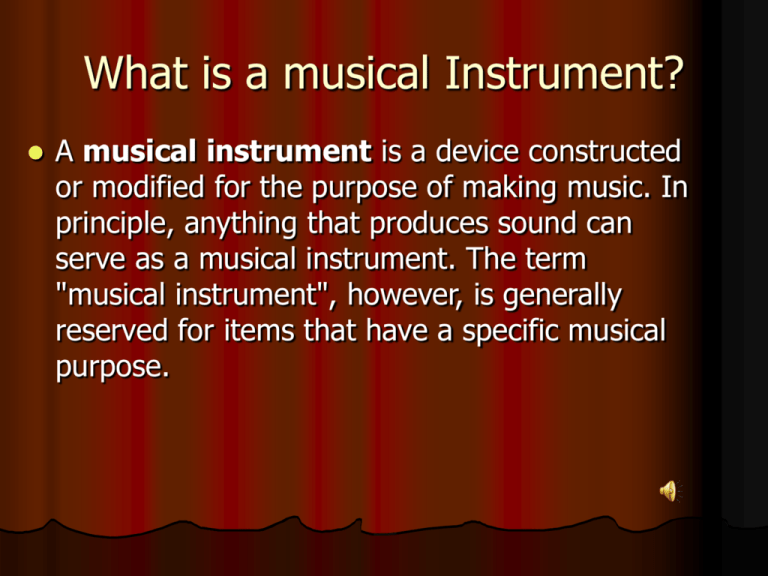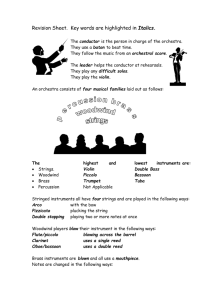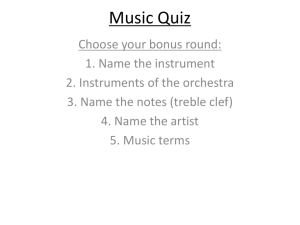Musical Instruments
advertisement

What is a musical Instrument? A musical instrument is a device constructed or modified for the purpose of making music. In principle, anything that produces sound can serve as a musical instrument. The term "musical instrument", however, is generally reserved for items that have a specific musical purpose. Types of Musical Instruments These categories are based on the mechanism by which the instrument makes its sound. String Instruments Percussion Instruments Wind Instrumets Brass Intrumets String Instruments Their sound is made by a vibrating string. Strings can be made of metal, synthetic or natural materials. The strings can have different gauge or thickness, weight, length and tension. Pictures of Some String Instruments Piano The piano is a musical instrument played by means of a keyboard that produces sound by striking steel strings with felt hammers that immediately rebound allowing the strings to continue vibrating at their resonant frequency. These vibrations are transmitted through a bridge to a soundboard that amplifies them. Guitar The guitar is a musical instrument with ancient roots that is used in a wide variety of musical styles. It typically has six strings, but four, seven, eight, ten, and twelve string guitars also exist. Violin The violin is a bowed string instrument with four strings tuned in perfect fifths. It is the smallest and highest-pitched member of the violin family of string instruments. Other Members of the violin family Cello Viola Bass Harp The harp is not like any other member of the string family. It has about 45 strings stretched across its tall triangular frame. The strings are plucked by hand while seven pedals at the bottom of the harp adjust the length of the strings to produce additional notes. Percussion Instruments With a name that means, "the hitting of one body against another," instruments in the percussion family are played by being struck, shaken, or scraped. In the orchestra, the percussion section provides a variety of rhythms, textures and tone colors. Pictures of Some Percussion Instruments Triangle The triangle is made from a small round steel tube, and is played by striking it with a steel beater. Its bright shimmering sound is untuned and resembles that of a bell. Chimes Chimes are a tuned instrument consisting of a set of 12 to 18 metal tubes hung from a metal frame. The chimes, or tubular bells, are struck with a mallet and sound like church bells when played. The longer the length of tube that is struck, the lower the pitch that is created. Xylophone The xylophone is a tuned instrument made of hardwood bars in graduated lengths set horizontally on a metal frame. Striking the bars with hard mallets produces a bright, sharp sound. The xylophone was originally modeled after an African instrument and its name is Greek, meaning "wood sound". Tambourine The tambourine is a shallow, handheld drum made of a circular wooden frame with a calfskin or plastic drumhead stretched across the top. The tambourine has small discs called jingles set into its circular frame which produce sound when the tambourine is shaken, rubbed, or struck on the drum head with the knuckles. Bass Drum The bass drum is much larger than a snare drum and is played on its side, so that either head may be struck. The beater or mallet for a bass drum is large with a soft material such as sheep's wool covering the end. Cymbals Cymbals are made from two large, slightly concave brass plates, are fitted with leather hand straps and are shaped so that when they are crashed together, only the edges touch. Although cymbals are untuned instruments, different sized cymbals produce a wide range of sound effects. Wind Instruments The three branches of the woodwind family have different sources of sound. Vibrations begin when air is blown across the top of an instrument, across a single reed, or across two reeds. Pictures of Some Wind Intruments Piccolo The piccolo is exactly like the flute except that it is much smaller and is usually made of silver or wood. The pitch of the piccolo is higher than that of a flute. Oboe The oboe is similar to the clarinet in many ways. Both are made from wood and have metal keys that can produce many notes rapidly. It has two reeds tied together. By placing them between one's lips and blowing air through them, the reeds vibrate and produce a sound. Saxophone Conically shaped, the saxophone is the only woodwind instrument made of brass. Although it is found only occasionally in the symphony orchestra, it is considered a member of the woodwind family because it has a single reed like the clarinet. Flute The flute is now made from silver or gold and is about 2 feet in length. It looks like a narrow tube with a row of holes covered by keys along one side. The player blows air across the small hole in the mouthpiece to produce a sound that can be either soft and mellow or high and piercing. Brass Instruments Brass Family instruments produce their unique sound by the player buzzing his/her lips while blowing air through a cup- or funnel-shaped mouthpiece. To produce higher or lower pitches, the player adjusts the opening between his/her lips. The mouthpiece connects to a length of brass tubing ending in a bell. Pictures of some Brass Instruments Tuba The tuba is the lowest sounding member of the brass family. The tuba has four to five valves and is held upright in the player’s lap. Trombone The trombone is larger than that of a trumpet, and gives the instrument a more mellow sound. Instead of valves, the trombone has a slide which changes the length of its approximately 9 feet of tubing to reach different pitches. Trumpet The trumpet is the highest sounding member of the brass family. The player presses the three valves in various combinations with the fingers of the right hand to obtain various pitches Thank You






